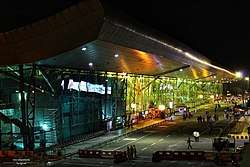Amritsar
Amritsar (Punjabi: [əmːˈɾɪtsəɾ] (![]()
Amritsar | |
|---|---|
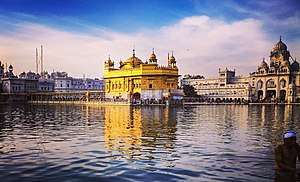 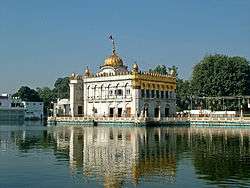 .jpg)  (clockwise from top) Harmandir Sahib, Jallianwala Bagh, Maharaja Ranjit Singh Statue, Khalsa College, Durgiana Temple | |
| Nicknames: Nicknames
| |
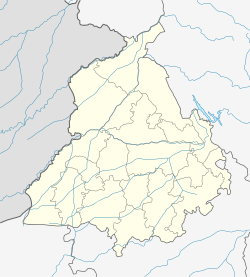 Amritsar  Amritsar  Amritsar | |
| Coordinates: 31.64°N 74.86°E | |
| Country | |
| State | Punjab |
| District | Amritsar |
| Founded by | Guru Ram Das |
| Government | |
| • Type | Municipality |
| • Body | Municipal Corporation Amritsar |
| • Mayor | Karamjit Singh Rintu (INC) |
| • Commissioner of Police | Sukhchain Singh Gill[1] |
| Area | |
| • Metropolis | 250 km2 (100 sq mi) |
| Population (2011) | |
| • Metropolis | 1,132,761 |
| • Density | 4,500/km2 (12,000/sq mi) |
| • Metro | 1,183,705 |
| Demonym(s) | Amritsari (Ambarsariya) |
| Time zone | UTC+5:30 (IST) |
| PIN | 143-001 |
| Telephone code | 91 183 XXX XXXX |
| Vehicle registration | PB01(Commercial), PB-02, PB-89 |
| Website | www |
According to the 2011 census, the population of Amritsar was 1,132,761. It is one of the ten Municipal Corporations in the state and Karamjit Singh Rintu is the current mayor of the city.[3] The city is situated 217 km (135 mi) northwest of state capital Chandigarh and 455 km (283 miles) northwest of New Delhi, the national capital. It is near Pakistan, with the Wagah Border being only 28 km (17.4 mi) away.
Amritsar has been chosen as one of the heritage cities for HRIDAY - Heritage City Development and Augmentation Yojana scheme of Government of India.[4] Amritsar is home to Harmandir Sahib, popularly known as "the Golden Temple," one of Sikhism's most spiritually significant and most-visited gurudwaras. The city is also known for its wooden chessboards and chess pieces manufacturing industry.[5]
History
The Bhagwan Valmiki Tirath Sthal situated at Amritsar is believed to be the Ashram site of Maharishi Valmiki, the writer of Ramayana.[6][7] As per the Ramayana, Sita gave birth to Lava and Kusha, sons of lord Rama at Ramtirth ashram. Large number of people visit Ramtirth Temple at annual fair. Nearby cities to Amritsar, Lahore and Kasur were said to be founded by Lava and Kusha, respectively. During Ashvamedha Yagna by Lord Rama, Lava and Kush captured the ritual horse and tied Lord Hanuman to a tree near to today's Durgiana Temple.
Founding of Amritsar City
Guru Ram Das, the fourth Sikh guru is credited with founding the holy city of Amritsar in the Sikh tradition.[8][9] Two versions of stories exist regarding the land where Ram Das settled. In one based on a Gazetteer record, the land was purchased with Sikh donations, for 700 rupees from the owners of the village of Tung.[10]
According to the Sikh historical records, the site was chosen by Guru Amar Das and called Guru Da Chakk, after he had asked Ram Das to find land to start a new town with a man-made pool as its central point.[11][12] After his coronation in 1574, and the hostile opposition he faced from the sons of Amar Das,[13] Ram Das founded the town named after him as "Ramdaspur". He started by completing the pool, and building his new official Guru centre and home next to it. He invited merchants and artisans from other parts of India to settle into the new town with him. The town expanded during the time of Arjan financed by donations and constructed by voluntary work. The town grew to become the city of Amritsar, and the pool area grew into a temple complex after his son built the gurdwara Harmandir Sahib, and installed the scripture of Sikhism inside the new temple in 1604.[9]
The construction activity between 1574 and 1604 is described in Mahima Prakash Vartak, a semi-historical Sikh hagiography text likely composed in 1741, and the earliest known document dealing with the lives of all the ten Gurus.[8]
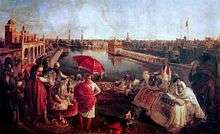
Jallianwala Bagh massacre
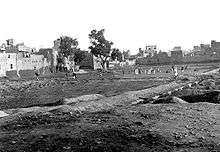
The Jallianwala Bagh massacre, involving the killings of hundreds of Indian civilians on the orders of a senior British military officer, Reginald Edward Harry Dyer, took place on 13 April 1919 in the heart of Amritsar, the holiest city of the Sikhs, on a day sacred to them as the birth anniversary of the Khalsa (Vaisakhi day).
In Punjab, during World War I (1914–18), there was considerable unrest particularly among the Sikhs, first on account of the demolition of a boundary wall of Gurdwara Rakab Ganj at New Delhi and later because of the activities and trials of the Ghadarites, almost all of whom were Sikhs. In India as a whole, too, there had been a spurt in political activity mainly owing to the emergence of two leaders: Mahatma Gandhi (1869–1948) who after a period of struggle against the British in South Africa, had returned to India in January 1915, and Annie Besant (1847–1933), head of the Theosophical Society of India, who on 11 April 1916 established the Home Rule League with autonomy for India as its goal. In December 1916, the Indian National Congress, at its annual session held at Lucknow, passed a resolution asking the king to issue a proclamation announcing that it is the "aim and intention of British policy to confer self-government on India at an early date".[14]
On 10 April 1919, Satya Pal and Saifuddin Kitchlew, two popular proponents of the Satyagraha movement led by Gandhi, were called to the deputy commissioner's residence, arrested and sent off by car to Dharamsetla, a hill town, now in Himachal Pradesh. This led to a general strike in Amritsar. Excited groups of citizens soon merged into a crowd of about 50,000 marchings on to protest to the deputy commissioner against the arrest of the two leaders. The crowd, however, was stopped and fired upon near the railway foot-bridge. According to the official version, the number of those killed was 12 and of those wounded between 20 and 30. Evidence before an inquiry of the Indian National Congress put the number of the dead between 20 and 30.
Three days later, on 13 April, the traditional festival of Baisakhi, thousands of Sikhs, Muslims and Hindus gathered in the Jallianwala Bagh. An hour after the meeting began as scheduled at 16:30, Dyer arrived with a group of sixty-five Gurkha and twenty-five Baluchi soldiers. Without warning the crowd to disperse, Dyer blocked the main exits and ordered his troops to begin shooting toward the densest sections of the crowd. Firing continued for approximately ten minutes. A British inquiry into the massacre placed the death toll at 379. The Indian National Congress determined that approximately 1,000 people were killed.
Operation Blue Star

Operation Blue Star (1 – 6 June 1984) was an Indian military operation ordered by Indira Gandhi, the Prime Minister of India[15] to curb and remove Sikh militants from the Golden Temple in Amritsar. The operation was carried out by Indian army troops with tanks and armoured vehicles.[16] Militarily successful, the operation aroused immense controversy, and the government's justification for the timing and style of the attack are hotly debated.[17] Operation Blue Star was included in the Top 10 Political Disgraces by India Today magazine.[18]
Official reports put the number of deaths among the Indian army at 83, with 493 civilians and Sikh militants killed.[19][20] In addition, the CBI is considered responsible for seizing historical artefacts and manuscripts in the Sikh Reference Library before burning it down.[21] [22] Four months after the operation, on 31 October 1984, Indira Gandhi was assassinated by two of her Sikh bodyguards in what is viewed as an act of vengeance. Following her assassination, more than 3,000 Sikhs were killed in anti-Sikh pogroms.[23]
Geography
Amritsar is located at 31.63°N 74.87°E[24] with an average elevation of 234 metres (768 ft).
Administrative towns
- Ajnala
- Attari
- Beas
- Budha Theh
- Chheharta Sahib
- Jandiala Guru
- Majitha
- Rajasansi
- Ramdass
- Rayya
- Verka Town
- Baba Bakala
Climate
Amritsar has a semiarid climate, typical of Northwestern India and experiences four seasons primarily: winter season (December to March, when temperatures can drop to −1 °C (30 °F), summer season (April to June) where temperatures can reach 45 °C (113 °F), monsoon season (July to September) and post-monsoon season (October to November). Annual rainfall is about 703.4 millimetres (27.7 in).[25] The lowest recorded temperature is −3.6 °C (25.5 °F), was recorded on 9 December 1996 and the highest temperature, 47.8 °C (118.0 °F), was recorded on 9 June 1995.[26] The official weather station for the city is the civil aerodrome at Rajasansi. Weather records here date back to 15 November 1947.
| Climate data for Amritsar Airport (1981-2010 normals, extremes 1947-present; humidity and sunshine 1961-1990) | |||||||||||||
|---|---|---|---|---|---|---|---|---|---|---|---|---|---|
| Month | Jan | Feb | Mar | Apr | May | Jun | Jul | Aug | Sep | Oct | Nov | Dec | Year |
| Record high °C (°F) | 26.8 (80.2) |
32.2 (90.0) |
36.2 (97.2) |
44.1 (111.4) |
47.7 (117.9) |
47.8 (118.0) |
45.6 (114.1) |
40.7 (105.3) |
40.6 (105.1) |
38.3 (100.9) |
34.2 (93.6) |
28.5 (83.3) |
47.8 (118.0) |
| Mean maximum °C (°F) | 23 (73) |
26.1 (79.0) |
32 (90) |
40.5 (104.9) |
44 (111) |
44.1 (111.4) |
39.8 (103.6) |
37.1 (98.8) |
36.8 (98.2) |
35.5 (95.9) |
30.5 (86.9) |
24.9 (76.8) |
45.2 (113.4) |
| Average high °C (°F) | 18.4 (65.1) |
21.7 (71.1) |
26.8 (80.2) |
34.2 (93.6) |
39 (102) |
39 (102) |
35 (95) |
34.2 (93.6) |
34.1 (93.4) |
32 (90) |
27.1 (80.8) |
21.1 (70.0) |
30.2 (86.4) |
| Average low °C (°F) | 3.4 (38.1) |
6.3 (43.3) |
10.9 (51.6) |
16.1 (61.0) |
21.3 (70.3) |
24.3 (75.7) |
25.3 (77.5) |
24.9 (76.8) |
22.1 (71.8) |
15.4 (59.7) |
8.7 (47.7) |
4.1 (39.4) |
15.2 (59.4) |
| Mean minimum °C (°F) | −0.5 (31.1) |
1.7 (35.1) |
5.6 (42.1) |
10.2 (50.4) |
15.8 (60.4) |
19.6 (67.3) |
21.7 (71.1) |
21.4 (70.5) |
17.8 (64.0) |
10.7 (51.3) |
4.2 (39.6) |
0.1 (32.2) |
−1.2 (29.8) |
| Record low °C (°F) | −2.9 (26.8) |
−2.6 (27.3) |
2 (36) |
6.4 (43.5) |
9.6 (49.3) |
15.6 (60.1) |
18.2 (64.8) |
18.8 (65.8) |
13 (55) |
7.3 (45.1) |
−0.6 (30.9) |
−3.6 (25.5) |
−3.6 (25.5) |
| Average rainfall mm (inches) | 26.2 (1.03) |
38.6 (1.52) |
38.4 (1.51) |
21.4 (0.84) |
26.7 (1.05) |
61.2 (2.41) |
210.1 (8.27) |
167.3 (6.59) |
77.5 (3.05) |
16.1 (0.63) |
6.3 (0.25) |
13.6 (0.54) |
703.4 (27.69) |
| Average rainy days (≥ 1.0 mm) | 2.1 | 3.3 | 3.2 | 2 | 2.4 | 3.8 | 8.6 | 6.9 | 3.5 | 1.1 | 0.6 | 1.4 | 38.9 |
| Average relative humidity (%) | 74 | 70 | 64 | 47 | 38 | 48 | 72 | 77 | 69 | 67 | 73 | 76 | 65 |
| Mean monthly sunshine hours | 181.7 | 192.7 | 219.4 | 265.0 | 294.7 | 269.0 | 215.5 | 227.7 | 240.8 | 253.2 | 220.1 | 182.2 | 2,762 |
| Source: [27][28] | |||||||||||||
Demographics
As of the 2011 census, Amritsar municipality had a population of 1,132,761[29] and the urban agglomeration had a population of 1,183,705.[2] The municipality had a sex ratio of 879 females per 1,000 males and 9.7% of the population were under six years old.[29] Effective literacy was 85.27%; male literacy was 88.09% and female literacy was 82.09%.[29] The scheduled caste population is 28.8%[30]
Religion

According to 2011 Census of India, Hinduism and Sikhism were the main religions of the Amritsar city at 49.4% and 48% of the population, respectively. In Amritsar city, Christianity was followed by 1.23% and Islam by 0.51%. Around 0.74% of the population of the city stated 'No Particular Religion' or another religion.[31]


Amritsar is the holiest city in Sikhism and millions of people visit it each year for pilgrimage.
Tourism
Amritsar is an attractive destination for tourists,[32][33] especially those part of Golden Triangle.[34] Major destinations are:
- Golden Temple[35] and Heritage Street[36]
- Punjab State War Heroes' Memorial & Museum[37]
- Bhagwan Valmiki Tirath Sthal[38]
- Sadda Pind[39][40]
- Urban Haat Food Street[41]
- Gobindgarh Fort[42]
- Ram Bagh Palace[43] and Maharaja Ranjit Singh Museum
- Wagah border[44]
- Partition Museum[45][46]
- Jallianwala Bagh[47]
- Jang-e-Azadi Memorial near Kartarpur, India[48]
Economy
Amritsar is the second-largest city and district of Punjab. It is also one of the fastest growing cities of Punjab. In the mid 1980s the city was famous for its textile industry. After the 1984 Sikh riots Amritsar faced a blow in Industrial growth but there are still many textile mills present in the city. It is famous for its Pashmina Shawls, Woolen Clothes, Blankets, etc. Among handicrafts, the craft of the Thatheras of Jandiala Guru in Amritsar district got enlisted on UNESCO's List of Intangible Cultural Heritage in 2014,[49] and the effort to revive this craft under the umbrella of Project Virasat is among India's biggest government-sponsored craft revival programs.[50]
Transport
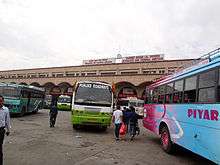
Air
Amritsar hosts Sri Guru Ram Dass Jee International Airport. The airport is connected to other parts of India and other countries with direct international flights to cities.
Rail
Amritsar railway station is the main terminus station. The Samjhauta Express runs from Delhi through Amritsar to Lahore in Pakistan.[51]
Road
Amritsar is located on the historic Grand Trunk Road (G.T Road), also known as NH 1 now renumbered as National Highway 3. Additionally, NH 54 (Old NH15), NH 354 and NH 503A connect Amritsar to other parts of state and rest of India.
Rs 450,000,000 is being spent to expand the Amritsar-Jalandhar stretch of G.T. Road to four lanes. In 2010, elevated road with four lanes connected to the National highway for better access to the Golden Temple has been started.[52]
Amritsar MetroBus
Amritsar has a bus rapid transit service, the Amritsar Metrobus which was launched on 28 January 2019. 93 fully air-conditioned Tata Marcopolo buses are used for the service connecting places like Golden Temple, Jallianwala Bagh, Guru Nanak Dev University and Khalsa College[53][54][55]
Educational institutions
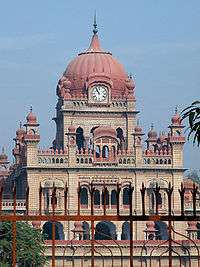
- Indian Institute of Management, Amritsar
- Guru Nanak Dev University
- D.A.V College
- Amritsar College of Engineering and Technology
- BBK DAV College for Women, Amritsar
- Delhi Public School, Amritsar
- Global Institute, Amritsar
- Government Medical College, Amritsar
- D.A.V Public School
- Khalsa College, Amritsar
- St. Francis School, Amritsar
- Khalsa College of Law
Medical facilities
- Dr. Vidyasagar Institute of Mental Health, a government mental hospital.[56]
- Government Medical College, Amritsar
- Sri Guru Ram Das University of Health Sciences, Sri Amritsar
See also
- Dussehra 2018 train disaster in Amritsar
- Amritsar Jamnagar Expressway
- Tarn Taran District
- Majha
- Sikhism
- List of people from Amritsar
- List of tallest buildings in Amritsar
References
- "Punjab Police Amritsar". amritsarcitypolice.gov.in. Retrieved 15 October 2019.
- "Provisional Population Totals, Census of India 2011; Urban Agglomerations/Cities having population 1 lakh and above" (PDF). Office of the Registrar General & Census Commissioner, India. Archived (PDF) from the original on 2 April 2013. Retrieved 26 March 2012.
- "List of Municipal Corporation in Punjab". www.punjabdata.com. Archived from the original on 14 January 2018. Retrieved 28 January 2018.
- "Introduction". HRIDAY official website. Archived from the original on 26 August 2015. Retrieved 30 April 2015.
- "Permit raj checkmates chessboard industry". The Tribune, 6 September 2018. 6 September 2018. Retrieved 27 April 2019.
- India, Press Trust of (22 November 2016). "Valmiki Tirath Sthal temple-cum-panorama to be opened on Dec 1". Business Standard India. Archived from the original on 3 August 2018. Retrieved 3 August 2018.
- nimmi. "Ram Tirth Temple, Indian Ram Tirth Temple, Ram Tirth Temple in India". Archived from the original on 10 October 2016. Retrieved 9 October 2016.
- W.H. McLeod (1990). Textual Sources for the Study of Sikhism. University of Chicago Press. pp. 28–29. ISBN 978-0-226-56085-4. Archived from the original on 14 February 2017. Retrieved 16 November 2018.
- Christopher Shackle; Arvind Mandair (2013). Teachings of the Sikh Gurus: Selections from the Sikh Scriptures. Routledge. pp. xv–xvi. ISBN 978-1-136-45101-0. Archived from the original on 5 March 2017. Retrieved 29 November 2018.
- Louis E. Fenech; W. H. McLeod (2014). Historical Dictionary of Sikhism. Rowman & Littlefield Publishers. p. 67. ISBN 978-1-4422-3601-1. Archived from the original on 5 March 2017. Retrieved 16 November 2018.
- Pardeep Singh Arshi (1989). The Golden Temple: history, art, and architecture. Harman. pp. 5–7. ISBN 978-81-85151-25-0.
- Louis E. Fenech; W. H. McLeod (2014). Historical Dictionary of Sikhism. Rowman & Littlefield Publishers. p. 33. ISBN 978-1-4422-3601-1. Archived from the original on 5 March 2017. Retrieved 16 November 2018.
- Arvind-Pal Singh Mandair (2013). Sikhism: A Guide for the Perplexed. Bloomsbury Publishing. pp. 38–40. ISBN 978-1-4411-5366-1. Archived from the original on 14 February 2017. Retrieved 29 November 2018.
- Proceedings of the Lucknow Session of the Indian National Congress, 1916, cited by Pasricha, Ashu (2008). The Political Thought of Annie Besant (Encyclopaedia of Eminent Thinkers, Vol. 25). Concept Publishing. p. 84. ISBN 978-8180695858.
- "Operation Bluestar, 20 Years On". Rediff.com. 6 June 1984. Archived from the original on 3 August 2009. Retrieved 17 July 2012.
- Ahmad, Ishtiaq (1996). State, Nation, and Ethnicity in the Contemporary South Asia. Continuum International Publishing Group. p. 130. ISBN 978-1-85567-578-0.
- Praagh, David Van (2003). The Greater game: India's Race With Destiny and China. India: McGill-Queen's University Press (MQUP). ISBN 978-0-7735-1639-7.
- Gunjeet K. Sra (19 December 2008). "10 Political Disgraces". Indiatoday.digitaltoday.in. Archived from the original on 20 December 2008. Retrieved 9 August 2009.
- Martha Crenshaw (1995). Terrorism in Context. Penn State Press. p. 385. ISBN 978-0-271-01015-1.
- Singh, Pritam (2008). Federalism, Nationalism and Development: India and the Punjab Economy. Routledge. pp. 44. ISBN 978-0-415-45666-1. Retrieved 29 July 2010.
- Kaur, Jaskaran; Crossette, Barbara (2006). Twenty years of impunity: the November 1984 pogroms of Sikhs in India (PDF) (2nd ed.). Portland, OR: Ensaaf. p. 16. ISBN 978-0-9787073-0-9. Archived (PDF) from the original on 19 January 2012. Retrieved 7 January 2012.
- Westerlund, David (1996). Questioning The Secular State: The Worldwide Resurgence of Religion in Politics. C. Hurst & Co. p. 1276. ISBN 978-1-85065-241-0.
- Singh, Pritam (2008). Federalism, Nationalism and Development: India and the Punjab Economy. Routledge. p. 45. ISBN 978-0-415-45666-1. Retrieved 29 July 2010.
- "Falling Rain Genomics, Inc – Amritsar". Fallingrain.com. Archived from the original on 11 August 2012. Retrieved 17 July 2012.
- "Amritsar Climate Normals 1981-2010" (PDF). Indian Meteorological Department, Pune. Retrieved 31 March 2020.
- "Amritsar Climate Normals 1981-2010" (PDF). Indian Meteorological Department, Pune. Retrieved 31 March 2020.
- "Amritsar Climate Normals 1981-2010" (PDF). Indian Meteorological Department, Pune. Retrieved 31 March 2020.
- "Amritsar Climate Normals 1971–1990". National Oceanic and Atmospheric Administration. Retrieved 11 January 2014.
- "State-wise, District-wise List of Blocks with >40% but less than 50% SC population". Archived from the original on 23 July 2013. Retrieved 12 July 2012.
- "Religion PCA - Amritsar". census.gov.in. Retrieved 13 November 2019.
- "The Golden Temple in Amritsar is now the most visited religious place in the world". Architectural Design | Interior Design | Home Decoration Magazine | AD India. 27 November 2017. Archived from the original on 31 July 2018. Retrieved 31 July 2018.
- "Golden Temple wins laurels as world's most visited religious place". The New Indian Express. Archived from the original on 31 July 2018. Retrieved 31 July 2018.
- Bagga, Neeraj (11 July 2018). "Amritsar, the emerging fourth angle of Golden Triangle". The Tribune Chandigarh. Archived from the original on 31 July 2018.
- "The Real Marigold Hotel: What a month in India taught me about the country's poverty, history and serenity". The Telegraph. Archived from the original on 31 July 2018. Retrieved 31 July 2018.
- "'Amritsar's Heritage Street in a shambles' - Times of India". The Times of India. Archived from the original on 15 August 2018. Retrieved 31 July 2018.
- "Amritsar: War memorial's Kargil gallery to be thrown open on July 15". hindustan times. 14 June 2018. Archived from the original on 30 July 2018. Retrieved 31 July 2018.
- "PUNJAB TO TRANSFORM 30 PLACES AS TOURIST ATTRACTION CENTERS". The Pioneer. 12 June 2018. Archived from the original on 30 July 2018.
- "Sadda Pind: Free entry ticket for meritorious students". The Tribune. 1 June 2018. Archived from the original on 31 July 2018.
- "Heritage project: Know real Punjab at 'Sadda Pind'". hindustan times. 23 October 2016. Archived from the original on 31 July 2018. Retrieved 31 July 2018.
- "As Punjab govt gears up to open Lahore-like food street in Amritsar, no takers for existing one". hindustan times. 26 February 2018. Archived from the original on 31 July 2018. Retrieved 31 July 2018.
- Dangwal, Sandhya (2 April 2017). "18th century Gobindgarh Fort thrown open to public after completion of its restoration work". India.com. Archived from the original on 31 July 2018. Retrieved 31 July 2018.
- Bagga, Neeraj (16 July 2018). "ASI lifts photography ban, tourists cheer". The Tribune. Archived from the original on 31 July 2018.
- "Crowd heads for Wagah border on long Independence Day weekend - Times of India". The Times of India. Archived from the original on 15 August 2018. Retrieved 31 July 2018.
- "The Partition Museum: Opening up about the pain". The National. Archived from the original on 31 July 2018. Retrieved 31 July 2018.
- "Tales of '47 move Trudeau at Partition Museum". The Asian Age. 26 February 2018. Archived from the original on 31 July 2018. Retrieved 31 July 2018.
- "Shaheed Udham Singh's 10-foot high statue to be inaugurated at Jallianwala Bagh on March 13". hindustan times. 10 March 2018. Archived from the original on 31 July 2018. Retrieved 31 July 2018.
- "Amarinder Singh opens second phase of Jang-e-Azadi memorial at Kartarpur - Times of India". The Times of India. Archived from the original on 25 August 2018. Retrieved 31 July 2018.
- "UNESCO - Traditional brass and copper craft of utensil making among the Thatheras of Jandiala Guru, Punjab, India". ich.unesco.org. Retrieved 1 July 2019.
- 24 Jun, Yudhvir Rana | TNN | Updated; 2018; Ist, 11:15. "Jandiala utensils: Age-old craft of thatheras to get new life | Chandigarh News - Times of India". The Times of India. Retrieved 1 July 2019.CS1 maint: numeric names: authors list (link)
- Kaur, Avinder (13 September 2013). "Amritsar Railway station - a night mare". Hindustan Times. Archived from the original on 6 January 2019. Retrieved 5 January 2019.
- "The Tribune, Chandigarh, India – Punjab". Tribuneindia.com. Archived from the original on 20 September 2012. Retrieved 17 July 2012.
- "Navjot Singh Sidhu launches BRTS project full throttle". www.punjabtribune.com. Archived from the original on 6 March 2019. Retrieved 3 March 2019.
- "Metro bus gets lukewarm response". The Tribune. 31 January 2019. Retrieved 6 November 2019.
- "Tata Motors commences delivery of new AC buses, with Automatic Transmission in Amritsar, for new BRTS operations". Tata Motors Limited. Retrieved 6 November 2019.
- Vinayak, Ramesh (23 May 2005). "Psychiatrist turns run-down mental hospital in Amritsar into institute of repute". India Today. Retrieved 14 January 2020.
External links
| Wikivoyage has a travel guide for Amritsar. |
| Wikimedia Commons has media related to Amritsar. |
